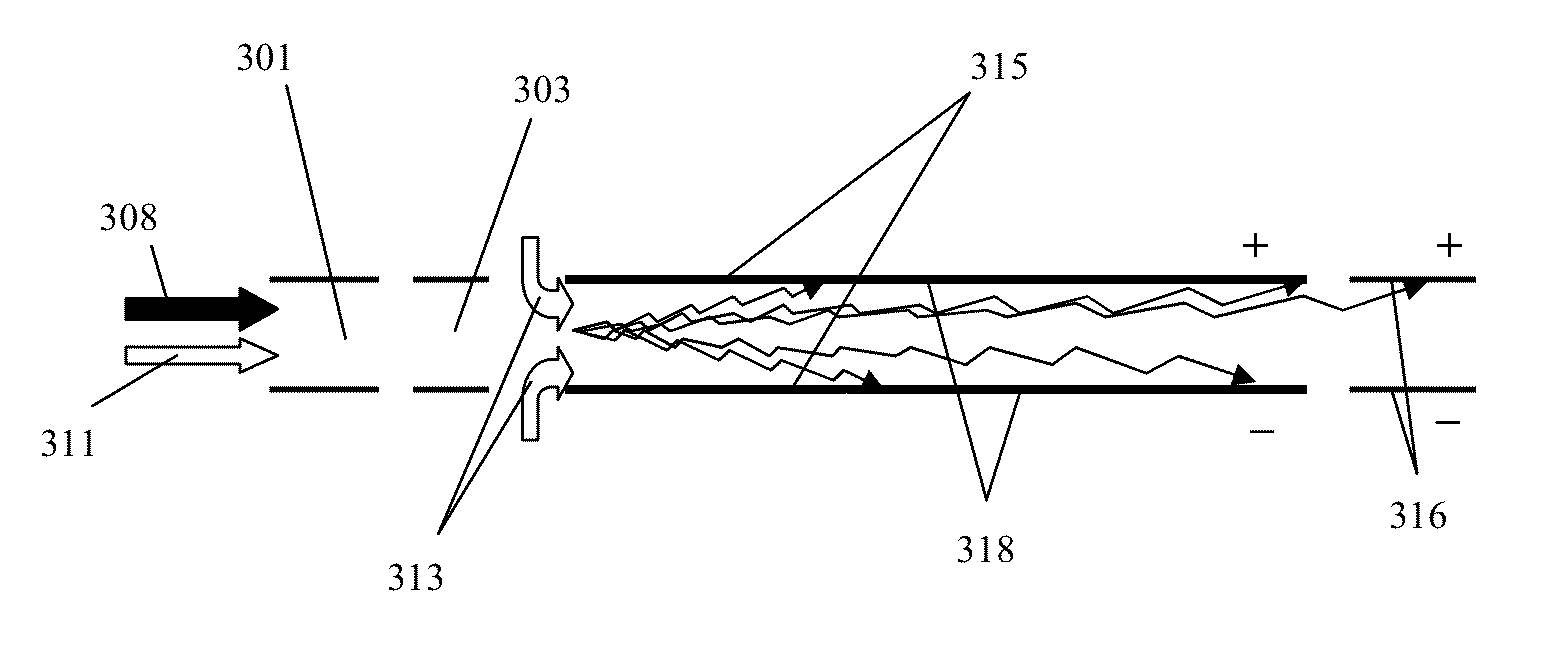Methods and apparatus for the ion mobility based separation and collection of molecules
a technology of ion mobility and molecules, applied in the direction of separation process, particle separator tube details, instruments, etc., can solve the problems of difficult rapid and efficient separation and collection of chiral compounds, process traditionally employed for enantiomer preparation, suffer from several drawbacks, and process, however, can be very time-consuming, so as to achieve enhanced separation and collection
- Summary
- Abstract
- Description
- Claims
- Application Information
AI Technical Summary
Benefits of technology
Problems solved by technology
Method used
Image
Examples
example 1
[0104]FIG. 13 shows superimposed ion mobility spectra of racemic mixtures in a pure nitrogen drift gas (no chiral modifier added). Each enantiomer in the electrospray solution was at a concentration of 100 ppm. Samples were introduced into the IMS via the electrosprayer with a flow rate of 1 μL / min. The enantiomeric mixtures showed in FIG. 13 are D- and L-valinol, D and L-threonine, D- and L-penicillamine, D and L-tryptophan, D- and L-methyl-α-glucopyranoside and R- and S-atenolol. These spectra represent data that can be obtained using a conventional ion mobility spectrometer. Even though these test enantiomeric mixtures could be separated from each other in the IMS, no enantiomeric separation was observed for the racemates in nitrogen drift gas without chiral modifier.
example 2
[0105]Atenolol is from a class of drugs called beta-blockers mainly prescribed alone or in combination with other medications to treat high blood pressure and lower heart rate, to prevent angina and to reduce the risk of recurrent heart attacks. Chiral Ion Mobility Separator (CIMS) separation of S- and R-atenolol enantiomeric mixture is illustrated in FIG. 14. When no chiral modifier was introduced to the drift gas, drift times for the S- and R-enantiomers were almost identical at 24.56 and 24.51 ms, respectively. In the CIMS, The drift times of S- and R-atenolol were 24.61 ms and 25.04 ms respectively when analyzed individually; the drift times of S- and R-atenolol were 24.66 ms and 25.06 ms when analyzed as a mixture. It was observed that drift time shift of R-atenolol was more significant compared to S-atenolol.
example 3
[0106]To illustrate how a chiral modifier affects separation in a CIMS, the drift times of individual enantiomers, L- and D-methionine, were recorded as a function of infusion flow rate of the chiral modifiers introduced into the drift gas. In the experiments, μL / min of a liquid chiral modifier, S-(+)-2-butanol or R-(−)-2-butanol, was pumped into and volatilized in the preheated nitrogen gas stream. The results of this investigation are shown in FIG. 15.
[0107]The drift times of methionine enantiomers increased with the introduction of chiral modifier, S-(+) or R-(−)-2-butanol. When S-(+)-2-butanol was used as the chiral modifier the drift time of both enantiomers, D- and L-methionine increased as a function of the concentration of the chiral modifier in the nitrogen drift gas. However, no difference in the drift time of the enantiomers could be seen until the chiral modifier flow rate reached about 30 μL / min. With only nitrogen as the drift gas, the drift time of both methionine ena...
PUM
| Property | Measurement | Unit |
|---|---|---|
| pressure | aaaaa | aaaaa |
| inner diameter | aaaaa | aaaaa |
| inner diameter | aaaaa | aaaaa |
Abstract
Description
Claims
Application Information
 Login to View More
Login to View More - R&D
- Intellectual Property
- Life Sciences
- Materials
- Tech Scout
- Unparalleled Data Quality
- Higher Quality Content
- 60% Fewer Hallucinations
Browse by: Latest US Patents, China's latest patents, Technical Efficacy Thesaurus, Application Domain, Technology Topic, Popular Technical Reports.
© 2025 PatSnap. All rights reserved.Legal|Privacy policy|Modern Slavery Act Transparency Statement|Sitemap|About US| Contact US: help@patsnap.com



